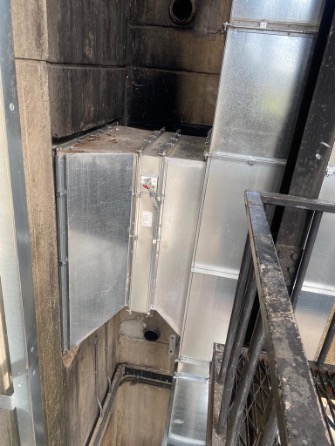-
Hazards of Smoke
Recent events have all too clearly illustrated how deadly smoke can be in the event of fire, especially in high rise buildings. The fire itself is obviously the generator of the smoke, but it is merely the transporter of the real killer.
Smoke restricts visibility which will cause disorientation to those escaping, which in turn obstructs evacuation, and, eventually, the toxic gases contained within the smoke, will result in asphyxiation.
-
Common Practice
Present day practice in smoke control is to adopt the system of depressurisation, a system which is based on allowing smoke to enter common escape routes before activation of the extract system.
When the depressurisation system is activated, it is common practice for the system to rely on the extract fan to create such a level of suction within the escape corridor that it pulls open the stairwell fire door in order to provide the makeup air. Creating the negative pressure within the corridor and stair could even lead to smoke being induced into the escape routes from the fire affected apartment or floor(s).
Current practice is also to design a smoke extract system based on a single fire on a single level. Recent experience of fires in multi-storey apartment buildings clearly demonstrates that fires in such buildings do not often respect this assumption.
-
Preferred Option & Proven Reliability
A pressurisation system on the other hand creates a positive pressure within the protected spaces, stopping smoke from entering the protected space in the first place; these systems are also designed to cater for changes that will inevitably occur as occupants escape from the building and the fire service enter.
A further key consideration is the reliability of the smoke control systems’ performance and its sustainability, that is whether it can continue to provide protection to escapees and the fire service personnel for the full duration of the fire and fire service operations. A depressurisation extract fan is designed to function at an elevated temperature and heavy smoke mass for up to two hours, whereas a pressurisation system handles cold air and will operate for however long the smoke control system is required. Fire service operations can last for many hours in multi-storey buildings.
Repeated operation of the pressurisation system being installed at the Fire Service College during real fire training exercises will provide the evidence to support this claim.

The pressurisation system fan installation
-
Collaboration with Fire Service College
With many years of experience in the design and installation of pressurisation systems, and a long term proponent of the use of such systems in high rise buildings, Advanced Smoke Group Limited announces that, in collaboration with the Fire Service College in Moreton in Marsh, we are now installing a pressurisation system in a multi-storey fire fighter training facility at the establishment.
The Moreton in Marsh based Fire Service College is a leading organisation for fire prevention and protection, providing assessed, accredited and assured fire and multi-service training for emergency service professionals globally.
The system that is installed is based on the latest control technology and will demonstrate the ease of commissioning, operating and reliability of modern pressurisation systems.

Pressurisation system ductwork
Fire fighters attending courses at Moreton in Marsh college will be able to see how pressurisation systems can rapidly react to the continuously changing conditions within a fire effected building, and how such a system can aid the fire service in their seek and rescue operations as well as fire-fighting.
Advanced Smoke Group will also be working with the college in conducting a number of seminars each year; these will include real fire demonstrations of the pressurisation system.

Hi-Protect
Hi-Protect Pressurisation System Installed by ASG at Fire Service College
Richard Brooks | 24th October 2022
